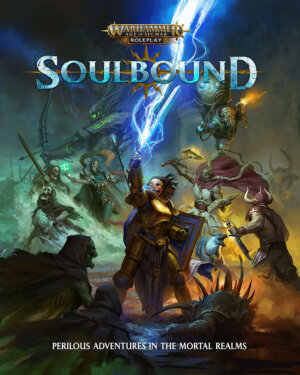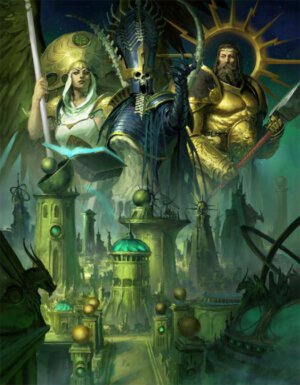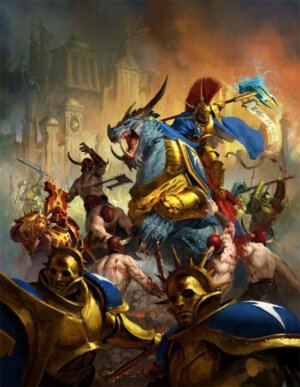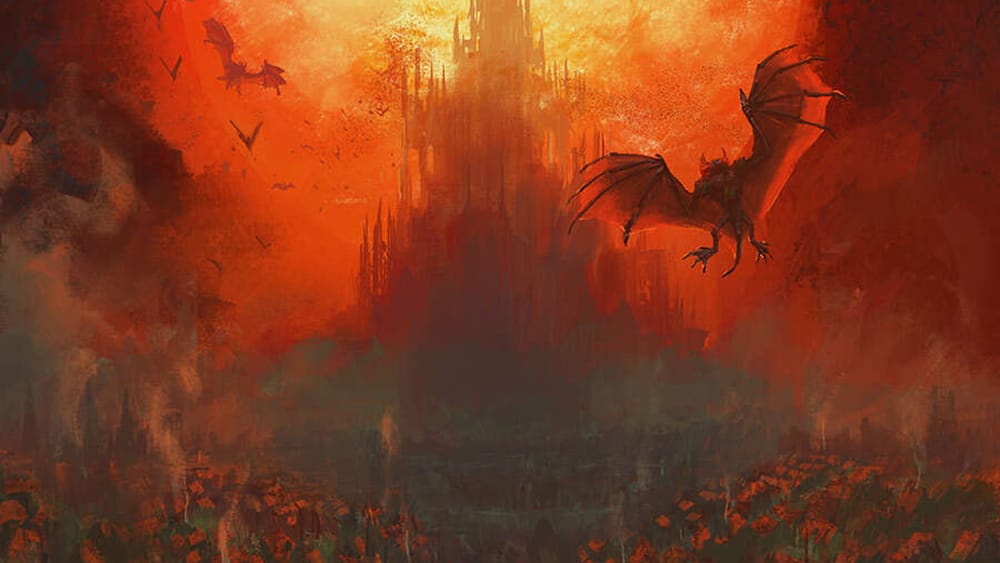
Publishers: Cubicle 7 Entertainment and Games Workshop
Authors: Emmet Byrne, Zak Dale-Clutterbuck, David Guymer, Elaine Lithgow, TS Luikart, Dominic McDowall, Katrina Ostrander, Josh Reynolds, Clint Werner
Illustrators: Carol Azevedo, Tom Babbey, Biagio D’alessandro, Mirko Failoni, Max Fitzgerald, Runesael Flynn, Mariusz Gandzel, Michele Giorgi, Johan Grenier, Pasi Juhola, Eve Koutsoukou, Dániel Kovács, Sam Manley, Clara-Marie Morin, JG O’Donohue, Rafael Teruel, Kim Van Deun, Sam White
Year: 2020
Genre: Fantasy roleplaying game
Pages: 352
Price: $59.99 Hardcover or $29.99 in PDF at DriveThruRPG
In Soulbound, players take on the role of either Stormcast Eternals, chosen warriors of the god Sigmar, or Soulbound — once-ordinary Humans, Aelves, Duardin, and Sylvaneths bound together with powerful magic to wage war against the force of Chaos and the Dark Gods.
Gameplay is fairly straightforward, with players rolling pools of d6 determined by trait and skill scores against a given difficulty number (DN). While combat can add some level of mechanical grit —such as allowing players to dynamically re-order initiative— it to places an emphasis on description over mechanics.
Soulbound draws deeply from Warhammer’s lore, a potentially intimidating prospect for those players coming in fresh. Though initially overwhelming, the game does a wonderful job of ensuring everyone, regardless of prior experience with the world, understands the fundamentals and can use them to create characters that truly reflect 
Character creation, it should be noted, is very much a group process. Though characters may not always like each other, their very souls have often been entwined and they share a common investment in the goals of the group. As such, players are encouraged to develop their characters in tandem with one another, hashing out relationship dynamics, history, and quirks. The GM is likewise an essential part of this process, not only as a resource and sounding board, but in helping to steer the tone of the narrative to come. Collaboration is essential to Soulbond in a way that it may not be for many other titles, reinforcing the notion that everyone at the table, regardless of role, is united in the common goal of telling an epic story — the only true description of Soulbound’s intended narrative arcs. By positioning itself so firmly in the established lore, the game sets the stakes for dramatic action, thrilling adventure, and dire consequence.
The story-first ethos undergirds every aspect of the game. Should players wish to play against gender in an archetype (e.g., a male Daughter of Khaine), they are given explicit support in the text. GMs are encouraged to think through the logical arc of enemies’ actions in combat to ensure players feel they are not being targeted and to cement the idea that it is the enemies against the characters, as opposed to the GM against the players. If a rule impedes exploration of a compelling narrative or otherwise prevents players from having fun, the Soulbound encourages ignoring the rule in question.
Customization is easy, thanks to clear and prominently displayed directions. Alternative rules are listed in a single location, separate from their standard counterparts, but no more challenging to find or understand. Clear and demonstrable efforts have been made to make the game as accessible as possible and to both support and encourage creativity from GMs and players alike.

The art is evocative, both inspiring new players and serving as a familiar touchstone for franchise veterans. Rendered in loving detail with vibrant colors, both full page spreads and small incidental works alike are a joy. While beautiful on screen, art aficionados may prefer a physical copy to fully appreciate the work on display.
Those with only a passing familiarity of Warhammer will no doubt have their thoughts drawn to the elaborate wargaming set ups and lovingly painted miniatures — which puts Soulbond in an interesting position. It is, in many ways, the antithesis of wargaming design principles and, as such, may disappoint those looking for a more mechanically gritty experience; by contrast, the image of Warhammer and its roots in wargaming may lead story-oriented players to bypass a title that offers a rich epic fantasy experience rife with lore and narrative potential on name alone.
Warhammer Age of Sigmar: Soulbound is a top-notch title offering tantalizing narrative possibilities, founded on mutual teamwork and cooperation in storycrafting. The game benefits from a clear introduction to the world for new players, easy-to-follow directions, and an emphasis on allowing players and GMs to customize as necessary. Less mechanically-involved than Dungeons and Dragons or Pathfinder, Soulbound is nevertheless a must buy for any fantasy tabletop roleplaying fan seeking an emotionally compelling campaign experience.
[rwp-review id=”0″]

















